How do you know if your digital marketing is up to par or if there are gaps or missed opportunities that could be costing you students and revenue? A digital marketing audit can help answer these questions, providing you with valuable insights to correct hidden and costly mistakes and achieve your objectives efficiently and effectively.
Putting your audit into action can be a way for your school to break out of a potential rut and elevate its marketing strategy. Here’s an overview of how a digital marketing audit can help your school build a stronger online presence and capitalize on new opportunities.
1. Discover Opportunities for Digital Improvement
What is a digital marketing audit, and how can it help your school? A digital marketing audit is an in-depth analysis of how your school’s digital efforts measure up against best practices for student recruitment, with the results presented in a final report. By conducting an audit, you can check how your school is performing across different channels and platforms, identify new opportunities for your school to shine, and discover ways to enhance your team’s productivity.
When looking at how to do a digital marketing audit, you should begin by reviewing your school’s business goals while also factoring in all the various activities you’re working on—including all of your inbound marketing efforts. You’ll want to start with SMART goals that give your school a clear roadmap to follow. With these goals in mind, you can audit your marketing efforts and track your performance more accurately.
The insights you uncover can help you boost your ROI, giving you an idea of how to better communicate your school’s message. Since inbound marketing covers a range of areas – from blog content and social media to email marketing – you can use your audit as a tool for catching any branding inconsistencies across different channels and platforms. This way, you can more easily establish your school’s credibility and build trust with your audience.
Refine Your School’s Student Personas with a Digital Marketing Audit
Your school has likely communicated with different prospects at different stages of the enrollment funnel and in different channels, like search ads, social ads, email and more. How successful were those efforts? Were there missed opportunities that, if capitalized on, could boost your efficacy? That is what a digital marketing audit can help you find out. To do this effectively, you’ll need to take a long, hard look at your student personas—and if you haven’t developed them yet, then it’s time to get started.
Student personas are semi-fictional representations of your prospects. These personas allow your school to refine its messaging and tailor its content to the specific needs and interests of its target audience(s). You want your personas to reflect your current audience, so it’s crucial to review your demographics. Over time, you may discover that your prospects’ needs or interests have shifted. Conducting a digital marketing audit for your school ensures that your personas’ background information, motivations, and concerns are still accurate. As a result, your messaging will continue to resonate and make an impact.
The example below shows the key information you need to have a firm grasp of your target audience. Featuring their background information, motivations, and concerns in a single document makes it easy for your school to instantly connect with them and craft engaging messaging.
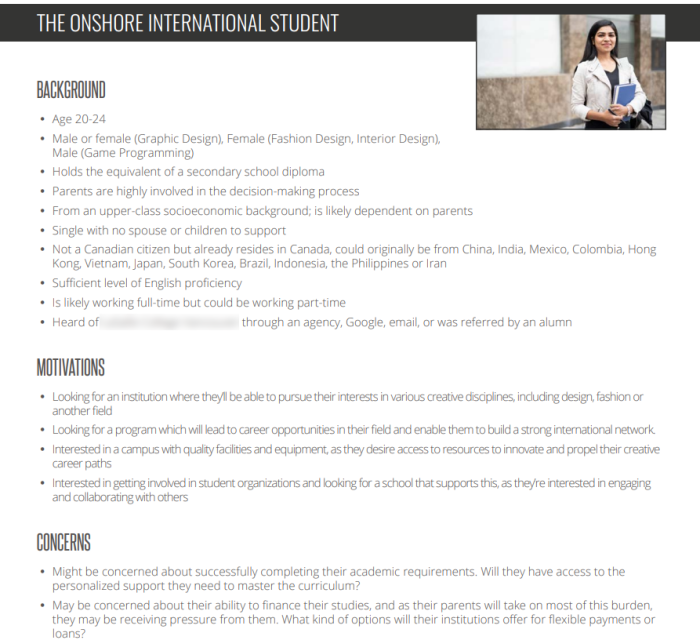
By reviewing your personas regularly, your school can track changes in your audience as they occur. This step ensures that you don’t risk missing key pain points and delivering the wrong message to your prospects.
Eager to connect with your prospects and refine your messaging? Reach out to our team for the opportunity to gain custom insights with a free digital marketing audit!
2. Identify Areas for Improvement in Your School’s Content Strategy
Your personas are critical to your content development efforts, but there’s more to it. In addition to reviewing your student personas, you can choose to audit your content and discover how your school is reaching prospects at different stages of the enrollment funnel. Generally speaking, you’ll want to have content made specifically for prospects who are just starting to learn about your school (awareness stage), for prospects who are still uncertain about enrolling (consideration stage), and for prospects who are ready to submit an online application (decision stage).
Example: The Minerva University Blog features content that appeals to prospects at different stages of the enrollment funnel. Here, blog posts share student voices, alumni stories, and application advice. This can attract prospects in the consideration stage as well as the decision stage, engaging them and preparing them to apply.
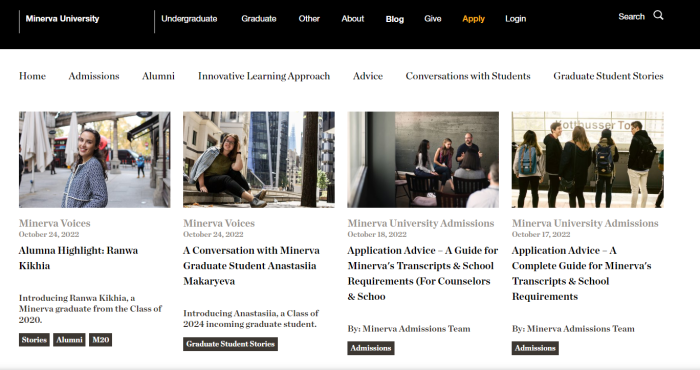
Source: Minerva University
Through a content marketing audit, you can analyze your TOFU to BOFU marketing efforts and determine your overall success. If you discover any gaps, then you can fill them with new content and capitalize on an opportunity to build a more robust content calendar.
A good strategy begins with a content inventory—a list that reveals web pages or assets you’d like to analyze. Once you’ve focused your efforts, you can begin evaluating the structure and format of your content and how online users interact with it.
Pro Tip: While conducting your digital audit, you may find that your content is no longer up to date. To capitalize on your current traffic and boost your SEO, you can consider historical optimization. This technique allows you to revitalize your content and make it more relevant to your audience while maximizing your SEO returns.
3. Optimize Your Social Media Efforts with a Digital Marketing Audit
It’s important to know what you want to achieve from your social media presence. Conducting a digital marketing audit can help you get the results you need. Once you’ve set your social media goals and KPIs, you’ll be in a position to better analyze your efforts and discover key strengths and weaknesses.
As you dive into your social media audit, you can analyze your click-through rate (CTR) and impressions. The general rule of thumb is that if your impressions are low, then you likely need to boost your brand awareness to reach your target audience. If you find that your impressions are high, but your CTR is low, then you can benefit from shifting your energy toward creating more compelling social media content to engage your audience.
Looking at your social media content calendar and posting frequency can help you evaluate your engagement levels. Some platforms can be more demanding than others, and they each can have their own set of user expectations. For instance, it’s recommended to post between three to seven times a week on Instagram and between one to five times a day on LinkedIn. Ultimately, you’ll want to aim for an engagement rate between 1% and 5%.
Example: Your school’s social media insights can be particularly instructive in guiding your social media efforts. You can use your audit as an opportunity to gauge impressions and other key metrics (as seen in the first image using a Twitter account) or to monitor engagement (as seen in the second image, highlighting Facebook posts):


Keeping tabs on these metrics through an audit can help you determine where your resources and efforts are needed most. Not only can you identify which channels to focus on, but you can also evaluate how your social media accounts drive traffic to your website, ultimately securing conversions.
4. Uncover Gaps in Your School’s SEO
In addition to working with changing personas, your school should stay on top of changing SEO best practices to stay ahead of its competition. Because the market is constantly evolving, your school needs to maintain its edge and relevance. This is why you may want to conduct an SEO audit.
To overcome obstacles you may face with the changing nature of your personas and search engine performance, you must consider both the user and the search engine. Nowadays, search engines want you to provide value to their users. This serves as an opportunity for you to take what you’ve discovered in your persona research and apply it through SEO-driven content.
First, through an SEO audit, you can ensure that your content incorporates the right keyword phrases. By conducting keyword research, you can tailor your content around what your audience cares most about. Essentially, you’ll be using words that are frequently used in your prospects’ search engine queries, boosting your website visibility.
The table below shows a snapshot of some high-gain keywords that a school offering pharmaceutical training can use to elevate its SEO strategy. This list can be generated as part of your school’s SEO audit:

Part of your audit can also focus on your on-page SEO tactics. These include optimizing your header tags, page titles, meta descriptions, body copy, and even image alt-text. The idea is that a well-optimized web page can make your content easier for search engines to parse through—boosting its ranking and increasing its CTR.
Example: One sign of good on-page SEO is integrating a focus keyword throughout the webpage. John Cabot University’s blog post does exactly that by featuring the focus keyword in the blog post title and meta description. The keyword can also be found in the body copy, including the subheading:


Source: John Cabot University
Finally, your audit needs to verify if your content has been optimized to appear in the many opportunities search engines offer for great content. For example, properly structured content, whether from your website or blog, can appear as the featured snippet for Google searches or in People also ask. Here’s how they might look on the search engine results page respectively:
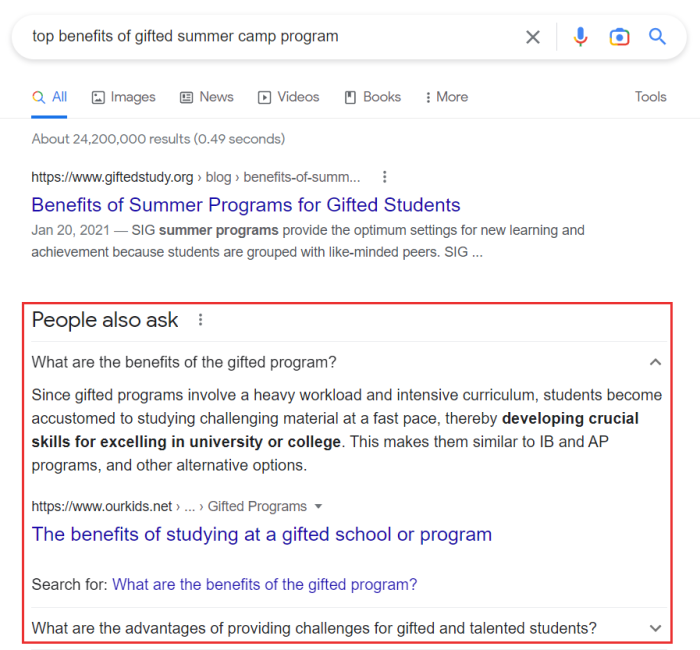

Pro Tip: An SEO audit gives your school the chance to review its backlinks, which is an indicator that search engines use to assess your website’s domain authority and credibility. Generally speaking, more backlinks from reputable websites can lead to a better search engine ranking. You’ll want to ensure that your school website links to reputable resources and is linked by some in return.
Using ahref’s free Backlink Checker, you can quickly view your domain rating (based on their 100-point scale) and the number of backlinks you’ve generated. Taking a look at this data can push you towards making necessary improvements to your school’s SEO strategy.

Source: ahref
Discover Ways to Optimize Your School’s Web UX
Web design is a big part of the prospect’s experience on your site. Good UX motivates users to stay or drives them to leave. With a digital marketing audit focused on user experience (UX), you can determine whether your school is doing enough to maintain its prospects’ interest.
There are many things to watch out for and assess in a web UX audit, but it’s generally good to start with the following:
- Overall web design
- Navigation system
- Mobile responsiveness
- 404 error pages and broken links
- Page speed and compressed images
By taking note of these factors and addressing any issues that come up, you can help decrease your website’s bounce rate. This means that users would be more likely to stay after clicking on your website and engage with other pages of content.
To help guide schools through this process, HEM offers a dedicated UX audit. In this report, industry experts analyze a school’s website to identify areas for improvement. The document below shows a snapshot of these efforts, revealing a few UX issues that a school can tackle, along with recommendations for extra support:
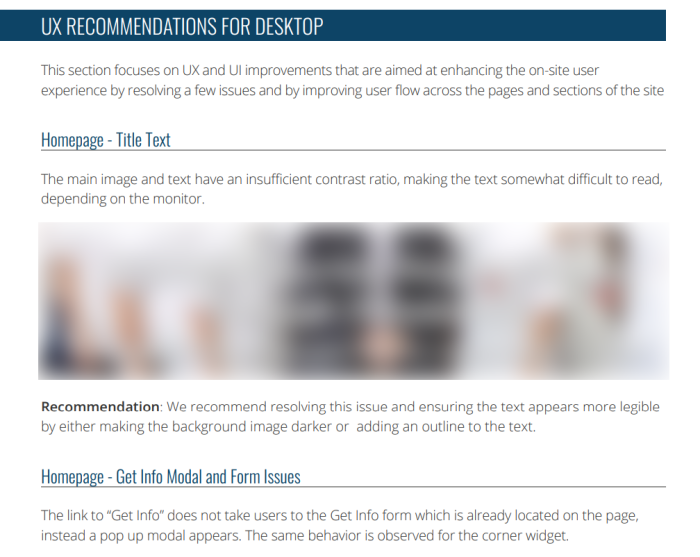
Going through your website in a digital marketing UX audit can be an effective way to discover new opportunities for streamlining the enrollment journey your prospects go through. This can mean that your potential students get the information they need more quickly and more efficiently and move from stage to stage to make a decision. Facilitate decision-making, and students decide faster.
5. Identify Missed Opportunities in Your Paid Advertising
If you’re running ad campaigns and are not seeing the results you’d hoped for, then a paid advertising audit is a great way to diagnose the problem. There’s a lot to gain from both search and social ads. However, it can be tricky to get it right. A digital marketing audit centered on paid advertising gives you the insight you need to meet your goals.
First, you’ll need to determine your KPIs and metrics to evaluate your success and compare your results with the industry standard. Some of the metrics you can monitor include:
- Click-through rate (CTR)
- CPC
- CPM
- CPA
- Engagement rate
- Conversion rate
- Relevancy score
If you notice that the performance of a specific metric is too low through your audit, then you can use this as a chance to make improvements by developing your paid advertising strategy. For instance, if your CTR isn’t as high as you’d like, then perhaps you need to look towards optimizing your landing pages and CTAs, making them more compelling and engaging. Similarly, if your impressions are too low, then you can devise a strategy that focuses on raising awareness, like potentially increasing your bid or adjusting your ad scheduling.
Schools running search ads can turn to Google Analytics for data, while those running social ads can visit their social media account for insights. For example, if you’re running a Facebook ad, then you’ll want to view the platform’s Insights to determine if you’re on the right track. Below is a snapshot of what you can expect to see:

By viewing this data, you can easily track your performance and consider new opportunities for improvement. Through your audit, you may also discover options you’ve overlooked and areas where you can potentially gain higher rewards. This can push you towards exploring other channels and ad-targeting settings. You may decide to switch to search advertising, display advertising, or even social media advertising—keeping track of each channel’s unique set of metrics and options, like keyword targeting and lookalike audiences.
Understanding those differences and regularly monitoring your performance ensures that you’re not wasting any time or resources on the wrong efforts, boosting your chances of a higher ROI.
6. Tap into Your School’s Potential with a Google Analytics Audit
Google Analytics allows your school to track various aspects of its website performance, including goals and conversions. This can be anything from application submissions and form completions to CTA clicks and event registrations. With a Google Analytics audit, you can take active steps to optimize your admissions funnel and better track your conversions.
By focusing on analytics in your digital marketing audit, you can uncover new conversion opportunities and develop strategies that help you implement them. You can also discover areas where your tracking is inaccurate, potentially causing discrepancies in your reporting.
Inviting analytics experts to view your Google Analytics account can help you ensure that your school is implementing industry best practices. Through HEM’s Google Analytics audits, schools can gain valuable insights and recommendations that allow them to improve their goal configuration and Google Analytics setup. The example below shows an excerpt from our report:
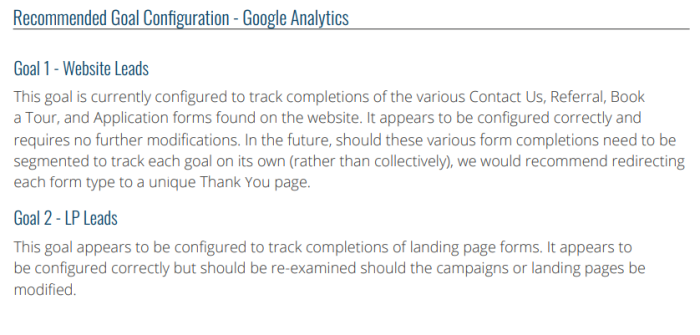
Implementing new strategies and recommendations revealed in your GA audit can help you take your digital marketing efforts to the next level. With the right insight and support, you can significantly enhance your student recruitment strategy and generate better results—making audits a powerful tool in your marketing toolbox.







